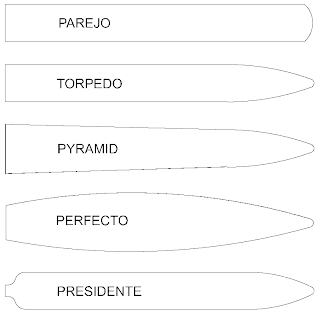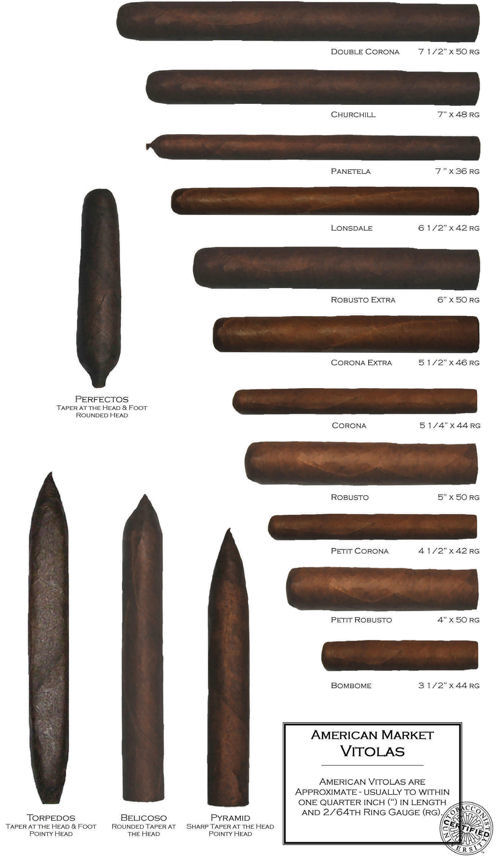Cigar 101 - Cigar Shapes
-
You might have asked yourself what's the difference between cigar shapes? I know there are box looking cigars and some that look like torpedo's so what the deal? Does it matter? Does it make them smoke better or taste different? Here's a quick quide to help.
Two primary things to consider. Length and ring gauge. For some neither are really a factor in buying and smoking a cigar and for some it's very important. For example I really don't care about ring gauge but length is important. I don't have a lot of time to smoke a cigar so I rarely get to smoke a Churchill which is 7 inches in length but I do have time to smoke something that is say 4 to 5 inches. Some people really only prefer a certain ring gauge over another. Small versus large or vice versus. It's really a matter of preference. No right or wrong.
I got the following info from Cigar Afficianado
http://www.cigaraficionado.com/webfeatures/show/id/8094/p/1
PAREJOS
Parejos are straight-sided cigars; most have an open foot for lighting and need to be cut before smoking. They may be either round or box-pressed, meaning that the sides of the cigar were pressed square prior to packing or, in some cases, by pressure in the box.
1 Corona
This is the benchmark size against which all other sizes are measured. The traditional dimensions are 5 1/2 to 6 inches with a ring gauge of 42 to 44. Example: Montecristo No. 3
2 Petit Corona
Basically a miniature corona, this cigar generally measures about 4 1/2 inches, with a ring gauge of 40 to 42. Example: Montecristo No. 4
3 Churchill
A large corona format. The standard dimensions are 7 inches by 47 ring gauge. Example: Romeo y Julieta Churchill
4 Robusto
A short, fat cigar that has become the most popular cigar size in America. The size is generally 4 3/4 to 5 1/2 inches by 48 to 52 ring gauge. Example: Cohiba Robusto
5 Corona Gorda
Also called a toro, this cigar is steadily growing in popularity. The traditional measurements are 5 5/8 inches by 46 ring gauge, but cigars of 6 inches by 50 ring have also become popular. Example: Punch Punch
6 Double Corona
The standard dimensions are 7 1/2 to 8 1/2 inches by a 49 to 52 ring gauge. Example: Hoyo de Monterrey Double Corona
7 Panetela
Long, thin and elegant, this size's popularity has decreased in recent years. Still, it is an elegant size, with a wide length variation of 5 to 7 1/2 inches with a ring gauge of 34 to 38. Cigars longer than 7 inches in this category are often referred to as "gran panetelas." Example: Cohiba Lancero
8 Lonsdale
A lonsdale is generally longer than a corona but thicker than a panetela, with a classic size of 6 1/2 inches by 42 ring. Example: Montecristo No. 1
FIGURADOS
Although the majority of cigars are parejos, a growing number of cigar companies are broadening their portfolios with more creatively shaped smokes. These cigars are called figurados, and they include any cigar that is not a straight-sided cylinder. Although cigar-makers' interpretations of the shapes vary as widely as the flavors inside their cigars, the basic categories of figurados are as follows:
9 Pyramid
Pyramids are cigars with cut feet, like parejos, but with heads tapered to a point. Generally the cigars measure from 6 to 7 inches in length, with ring gauges of about 40 at the head widening to 52 to 54 at the foot. The pyramid is treasured because the tapered head allows the complex flavors of the cigar to meld in the mouth. Example: Montecristo No. 2
10 Belicoso
Traditional belicosos are short pyramids, often with a slightly rounded pyramid head. They often measure from 5 to 5 1/2 inches, with ring gauges of about 50. Today's belicosos, however, are often coronas or corona gordas with tapered heads. Recent years have also seen the production of mini-belicosos, short cigars with small ring gauges and tapered heads. Example: Bolivar Belicoso Fino
11 Torpedo
Although many companies include cigars called torpedos in their portfolios, the cigars are often pyramids. A true torpedo is a rare cigar today, a smoke with a closed foot, a head tapered to a point, and a bulge in the middle. Example: Cuaba Millennium
12 Perfecto
Like the torpedo, the perfecto has a closed foot and a bulge in the middle. Unlike torpedos, though, the head of a perfecto is rounded like the head of a parejo. Perfectos very greatly in length, from a diminutive 4 1/2 inches to unwieldy 9-inch cigars, with ring gauges from 38 to 48. Example: Partagas Presidente
13 Culebra
More popular in the past than it is today, the culebra is perhaps the most exotic shape of cigar made. It consists of three panetelas braided together and tied with string, sold as one cigar. The three parts are then unbraided and smoked separately. Usually 5 to 6 inches long, culebras most often have a 38 ring gauge. Since they are difficult to come by today, you might consider sharing the other two braids of the cigar with two friends, turning the smoking of a culebra into a special occasion. Example: Partagas Culebra
14 Diadema
Diademas are enormous, 8 1/2 inches or longer. The head is tapered, though often not to a complete point, usually with a 40 ring gauge. The cigar then tapers down to a foot that can be open like a parejo or closed like a perfecto, usually with a ring gauge of 52 or greater. This is a cigar to be enjoyed when time is no object. Example: Hoyo de Monterrey Diadema
COLORS
Cigar wrappers come in a wide array of colors, from the palest of greens and yellows to dark black. Just as there are seven basic colors that make up the rainbow, there are seven basic color distinctions among wrappers, with an infinite number of shades between each color. A simple way to begin understanding the color designations is to remember that, just as the state of Colorado is in the middle of the United States, the color "colorado" comes in the center of the color range. Wrapper leaves vary in color due to the many methods for processing tobacco and the variety of tobacco strains used. Additionally, sunlight can play a factor: a wrapper grown in sunlight is typically darker than a shade-grown wrapper of an equivalent seed strain. From light to dark, the seven commonly used wrapper color descriptions are:
15 Double Claro
(also called Candela) This wrapper is light green, a hue created by a quick-drying process using heat that locks in the green chlorophyll of the tobacco. Years ago, this wrapper was tremendously popular in the United States, and it was a point of amusement for Europeans.
16 Claro
A light tan color, most commonly achieved by growing in shade under cheesecloth tents, picking the plants early and air-drying the leaves. Flavorwise, these wrappers have little to offer, and allow the flavors of the filler tobaccos to dominate the taste of the cigar.
17 Colorado Claro
Light reddish-brown; often grown in direct sunlight, and given longer to mature before picking.
18 Colorado
The center of the color scale. These cigars are medium-brown to brownish-red and full flavored, though soft and subtle in their aroma. These wrappers are often shade grown.
19 Colorado Maduro
Darker than colorado, lighter than maduro.
20 Maduro
This shade can vary from a deep reddish-brown to almost black. Maduro means "mature" in Spanish, which refers to longer time needed to cure this color wrapper than wrappers that are lighter. For maduros, leaves are either toasted in a pressure chamber or fermented longer in above-average heat. A maduro wrapper lends significant flavor to a cigar: it tends to be mild in aroma, but to have robust, almost sweet flavor.
21 Oscuro
This black-as-night wrapper shade is achieved by leaving the leaves on the plant as long as possible, by using only the leaves from the top of the plant, and by fermenting them for an especially long time. Most often Brazilian or Mexican in origin, oscuro wrappers are often very rough, a result of the extra fermentation. This category is sometimes referred to as "black," "negro" or "double maduro." -
Here are the common shapes:

-
Here is an example of a Culebera, which are kinda rare to find.

-
I also like this image to show different shapes and lengths.

-
Last but not least here is a good guide for ting gauges:

-
One more image:


